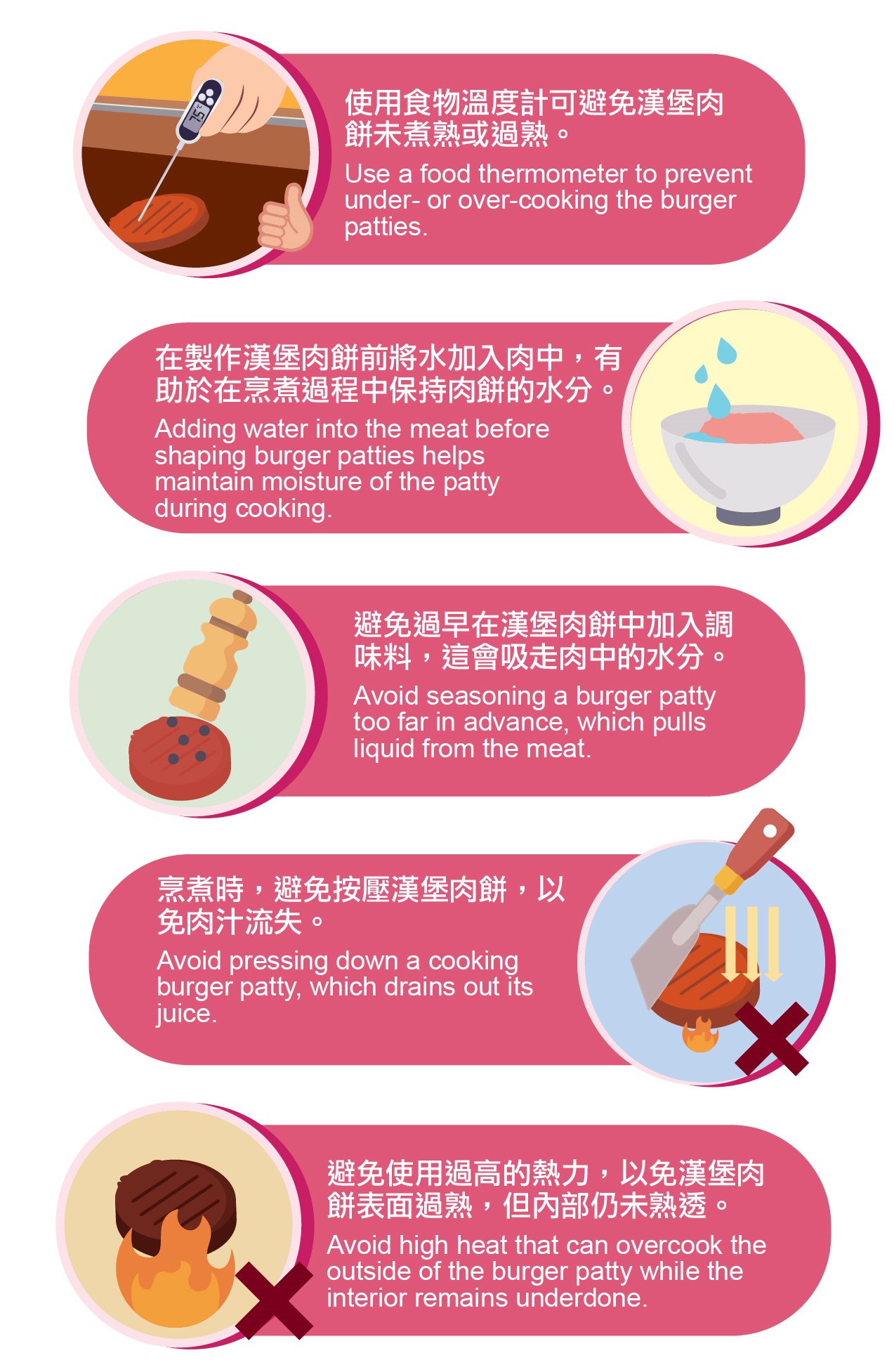
Food Safety Focus (191th Issue, June 2022) – Article 1
Handling of Burgers in Local Restaurants – From a Food Safety Perspective
Reported by Ms. Melva CHEN, Scientific Officer,
Risk Communication Section, Centre for Food Safety
In Hong Kong, ‘gourmet-style’ burger restaurants have become a recent food trend. Some of them sell less than fully cooked burger patties that give a taste and mouthfeel considered to be distinct from their well-done counterparts. However, eating undercooked burgers can result in foodborne illness or contracting antimicrobial resistance (AMR) microorganisms. The Centre for Food Safety (CFS) has recently conducted a study to explore the knowledge, attitudes and practices of food handlers on the preparation of beef burgers. This article will share the findings of the study. .
Serving Undercooked Burgers at Restaurants is not Uncommon
Food poisoning outbreaks associated with undercooked burgers or minced beef have been reported overseas and locally. Upon mincing, harmful bacteria such as pathogenic Escherichia coli and Salmonella as well as AMR bacteria (‘superbugs’) from the raw meat’s surface can be mixed throughout the whole piece of meat patty. Without thorough cooking, these bacteria can remain alive on the inside. Whether or not ‘superbugs’ cause acute symptoms, they may transfer their antimicrobial resistance genes to other bacteria inside the human body, hampering the effectiveness of antibiotics when needed in the future.
A telephone survey was conducted by the CFS in 2021, interviewing over 1000 restaurants that provided burgers, including fast-food and table-service restaurants. It revealed that more than 40% of restaurants provided undercooked burger patties upon request. Undercooked burger patties were more likely to be served at higher-priced restaurants.
Misconceptions and Unsafe Practices of Preparing Burgers
Following face-to-face interviews and observations of 24 randomly selected restaurants, it was discovered that food handlers, in general, lacked comprehension of the ‘5 Keys to Food Safety’, as well as the microbiological risks of undercooked meats. Some food handlers thought that high-quality beef patties could be eaten undercooked. Since food handlers believed that well-done burger patties were inferior in terms of juiciness, texture and flavour, some of them undercooked their burger patties by default to meet customers' tastes. The majority of food handlers were unaware of the safe internal temperature-time combinations (Figure 1).

Figure 1: Safe internal temperature-time combinations that are sufficient to kill most bacteria in burger patties
Most food handlers did not use a food thermometer to verify doneness, relying on subjective indicators such as texture and colour instead. When the temperatures were measured on site, all medium and most medium-well burgers as ordered were found to be undercooked, in other words not achieving any one of the safe internal temperature-time combinations. When the interviewed restaurants were requested to prepare well-done burgers, about one-fifth of them were still found undercooked. As a result, this might endanger customers who unintentionally ate the undercooked burgers. On the other hand, several food handlers overcooked their patties, say the internal temperature reaching over 85°C for a few minutes, while asked to prepare a well-done burger. This explains why they thought well-done burgers were dry and would be, therefore, refused by diners. In fact, thorough cooking does not mean sacrificing the flavour and juiciness of the patty. There are some practical culinary tips that both the trade and the public could consider (Figure 2).
Using a food thermometer not only can prevent food handlers from undercooking the meat, but also help them not to overcook at the same time. The study showed that sensory cues used by food handlers are not very reliable in determining doneness and securing food safety. Cooked meat colour is primarily due to the denaturation of myoglobin, a type of red pigment of muscles, and the Maillard browning. The amount of time minced meat exposed to air before cooking, pH and end-point temperature can influence the interior colour of cooked minced meat products. Premature browning of the meat surface may occur when the inside of fried patties looks dull brown or well-done before reaching the required temperature for killing harmful microorganisms. Consequently, premature browning may contribute to undercooking of minced beef if food handlers use brown visual colour alone as a doneness indicator.

Figure 2: Tips for making thoroughly cooked yet juicy burgers
What Can be Done to Reduce the Risk?
Knowing the repercussions of poor food hygiene can help people follow food safety recommendations more closely, reducing the risk of food contamination and foodborne illness. The CFS has published a the Trade Guideline on Safe Preparation of Beef Burgers, incorporating the concepts of the '5 Keys to Food Safety' and Good Hygiene Practices, for food handlers. To safeguard food safety, food handlers should use a food thermometer to ensure that the food's core temperature reaches a safe level for a specific time. When ordering burgers in restaurants, consumers are recommended to request for well-done. If a restaurant serves an undercooked burger, send it back to be thoroughly cooked such that it is safe to eat.
In the next issue, we will talk about some common misunderstandings of food handlers concerning undercooked meat.

